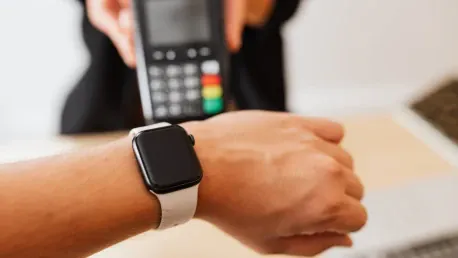Wearable payments technology is rapidly transforming the way consumers engage with financial transactions. Integrating style, convenience, and security, smartwatches and fitness trackers offer hands-free payment solutions that are becoming increasingly popular. By providing users an effortless and secure way to conduct transactions, wearable payments are set to revolutionize digital commerce by 2027.
Market Value and Growth Projections
The wearable payments market is on a significant growth trajectory, with projections indicating a boom in value by 2027. By then, the market is expected to be worth $114 billion, driven by increasing consumer demand and continuous technological advancements. This remarkable growth is anticipated to occur at an impressive compound annual growth rate (CAGR) of 21% from 2023 onward. Through the increasing adoption of wearable devices for financial transactions, the market expansion is receiving a significant push.
Global adoption rates are also on the rise, underscoring the wide acceptance and potential of wearable payments. By the end of 2023, a remarkable 45% of active smartwatch users worldwide are predicted to engage in wearable payments. The Asia-Pacific region has reported a notable 30% increase in adoption, while Europe has experienced an 18% growth in the same period. These figures highlight the regions with robust market expansion and growing popularity of wearable payments across various demographics.
User Demographics and Adoption Trends
The widespread adoption of wearable payments is driven by specific user demographics, particularly Gen Z and Millennials, who constitute a substantial 67% of the user base. Known for their tech-savviness and preference for convenience, these age groups are prime candidates for adopting wearable payments. Interestingly, this trend is not confined to younger generations alone. Adoption among Baby Boomers has also grown by 12%, indicating the technology’s broad cross-generational appeal.
The increasing acceptance of wearable payments among various age groups is a testament to the technology’s versatility and user-friendly nature. As people across different demographics become more comfortable using wearable devices for financial transactions, the market is expected to continue its upward trajectory. This acceptance highlights the demand for innovative and convenient payment solutions that wearable technology can efficiently provide.
Security and Trust in Technology
Security is a critical factor in the adoption and growth of wearable payments. The integration of stringent security measures such as biometric authentication has been pivotal in boosting user confidence, with 92% of users leveraging biometric security features. Various safeguards, including tokenization and end-to-end encryption, are standard measures to ensure transactions are secure. These features give users peace of mind when making payments through their wearable devices.
These security enhancements are essential in building trust among users and encouraging wider adoption of wearable payments. As technology advances, even more robust security features are expected to be integrated into wearable devices, further enhancing user confidence. This continuous improvement in security measures is likely to address many of the concerns surrounding digital transactions, paving the way for broader acceptance and use.
Device Dominance and Key Players
Smartwatches lead the wearable payments market, representing a commanding 60% of wearable payment devices in 2023. Established brands like Apple, Samsung, Garmin, and Fitbit are the most influential players in this space. By integrating NFC (Near Field Communication) and biometric technologies into their devices, these companies have been at the forefront of innovation, continually improving their products to meet consumer demands.
The dominance of smartwatches in the wearable payments market is a clear indication of their popularity and effectiveness. As these devices become more advanced and feature-rich, their adoption for financial transactions is expected to grow even further. This growth is supported by the continuous efforts of leading tech brands to enhance the functionality and security of their smartwatches, making them indispensable tools for modern consumers.
Expansion into Other Sectors
While retail payments dominate the landscape of wearable transactions, their applications are rapidly expanding into other sectors. Public transit, healthcare, smart home services, charity donations, and event ticketing are areas witnessing substantial growth in wearable payments. The versatile nature of these devices makes them suitable for a wide range of applications, further driving their adoption across different industries.
This expansion highlights the technology’s potential to revolutionize various aspects of daily life. As more industries embrace wearable payments, the convenience and efficiency they offer will become even more apparent. The integration of wearable payment solutions into different sectors is likely to streamline operations and enhance user experiences, thereby promoting broader adoption.
Regional Market Analysis
Regional analysis of the wearable payments market provides valuable insights into its growth patterns. North America dominates the market, holding a 45% share of wearable payment revenue. The region’s strong technological infrastructure and high consumer adoption rates contribute to its leading position. In addition, the Asia-Pacific region exhibits fast growth, with adoption rates increasing by 35%. Significant growth trends are also observed in Europe and Latin America.
Understanding these regional trends is crucial for businesses and policymakers. With each region having unique characteristics and requirements, tailored strategies can help drive further adoption and growth. Enhanced regional focus allows for addressing market-specific challenges and leveraging the distinct advantages each region presents, fostering global expansion.
Technological Advancements and Future Innovations
Technological advancements are central to the evolution and success of wearable payments. Integration with blockchain technology for secure transactions, improved battery life, and the incorporation of AI for personalized user experiences have pushed innovation forward. These technological improvements make wearable payments more efficient, secure, and user-friendly, catering to the ever-evolving needs of modern consumers.
Another notable trend is the prevalence of multicurrency and contactless payments. In 2023, 50% of wearable devices launched supported multicurrency transactions, while 90% of new wearable models were contactless compatible. This advancement caters to global users, making wearable payments more accessible and convenient. The ongoing innovation in wearable technology suggests a future where payments are seamless and integrated into everyday life.
Consumer Preferences and Market Challenges
Wearable payments technology is quickly changing how consumers handle financial transactions. Combining style, ease of use, and security, devices like smartwatches and fitness trackers offer convenient, hands-free payment options that are gaining immense popularity. These wearables provide users with a seamless and secure method to make transactions, positioning themselves as the future of digital commerce.
With the rise of contactless payments and the increasing integration of technology into everyday items, wearable payments are set to make significant headway by 2027. These advances allow users to perform tasks ranging from buying a coffee to purchasing a train ticket, all without needing to take out a wallet or phone. The technology embedded within these wearables encrypts user data, ensuring that transactions are not only effortless but also safe from potential fraud.
Moreover, the incorporation of biometric verification methods like fingerprint scanning and facial recognition further enhances the security features of wearable payment gadgets, mitigating risks associated with traditional payment methods. Retailers and financial institutions are also jumping on the bandwagon, developing infrastructure to support this burgeoning mode of payment. The expected widespread adoption of wearable payments will likely influence broader aspects of consumer behavior and financial services, ushering in a new era of digital convenience and security.









